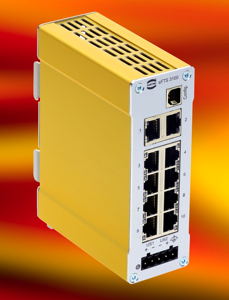Ethernet switches give priority to automation data
![]() Harting has developed an Ethernet switching technology that, it says, will make it easier for manufacturers to integrate their office and automation networks in a single Ethernet-based system. Unlike other approaches, which use modified versions of Ethernet, Harting says that its Fast Track Switching system uses standard Ethernet, but adds a new switching method to ensure that automation requirements for performance and determinism are achieved.
Harting has developed an Ethernet switching technology that, it says, will make it easier for manufacturers to integrate their office and automation networks in a single Ethernet-based system. Unlike other approaches, which use modified versions of Ethernet, Harting says that its Fast Track Switching system uses standard Ethernet, but adds a new switching method to ensure that automation requirements for performance and determinism are achieved.
The key to the protocol-independent system is a range of Fast Ethernet switches which detect real-time automation frames and give them right-of-way over non-real-time frames. The switches can identify automation profiles such as Profinet, Ethernet/IP and Modbus TCP, accelerate their transmission speeds and prioritise them.

The first Fast Track switch to be released is the unmanaged Ha-Vis FTS 3100s-A (shown above), which allows up to ten network devices to be connected using shielded, twisted-pair cables. It supports 10 or 100 Mbit/s Ethernet. The switch is configured using a software application called FTS Manager, which allows users to specify which automation protocols need to be detected and prioritised.
The Fast Track technology allows components and sub-systems which may not support automation-specific protocols – such as vision or RFID systems – to be integrated into automation networks via their Ethernet ports.

